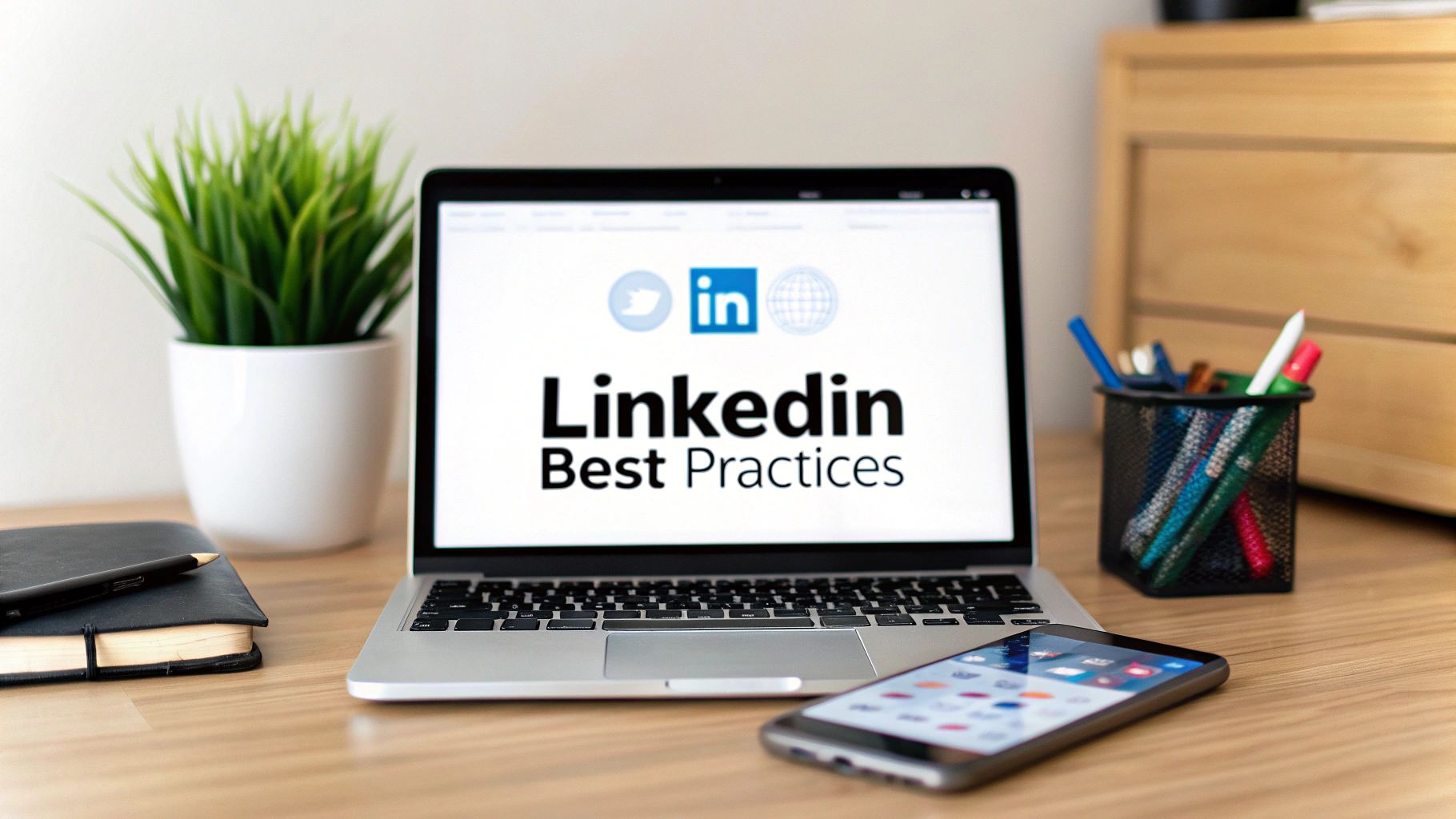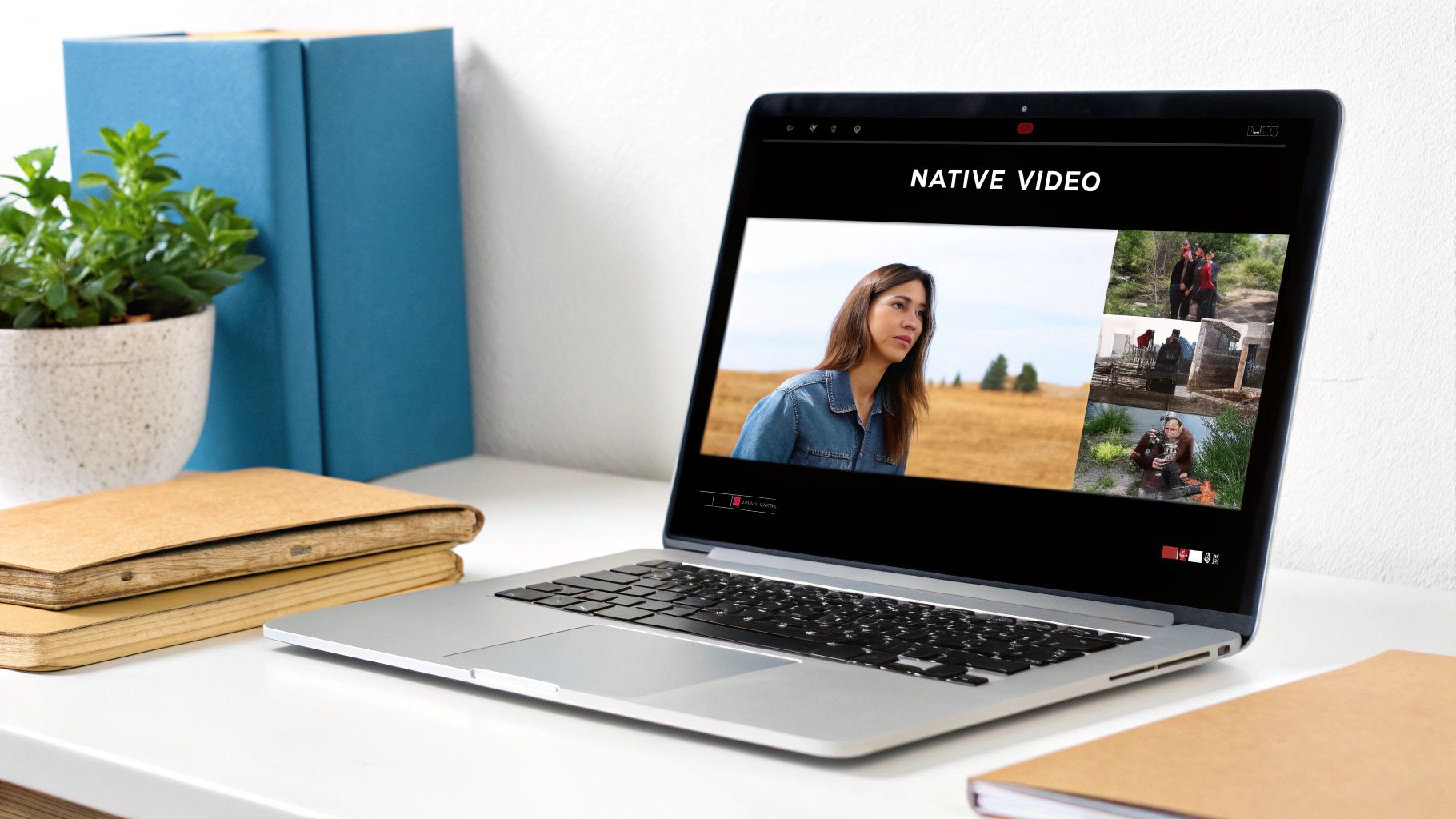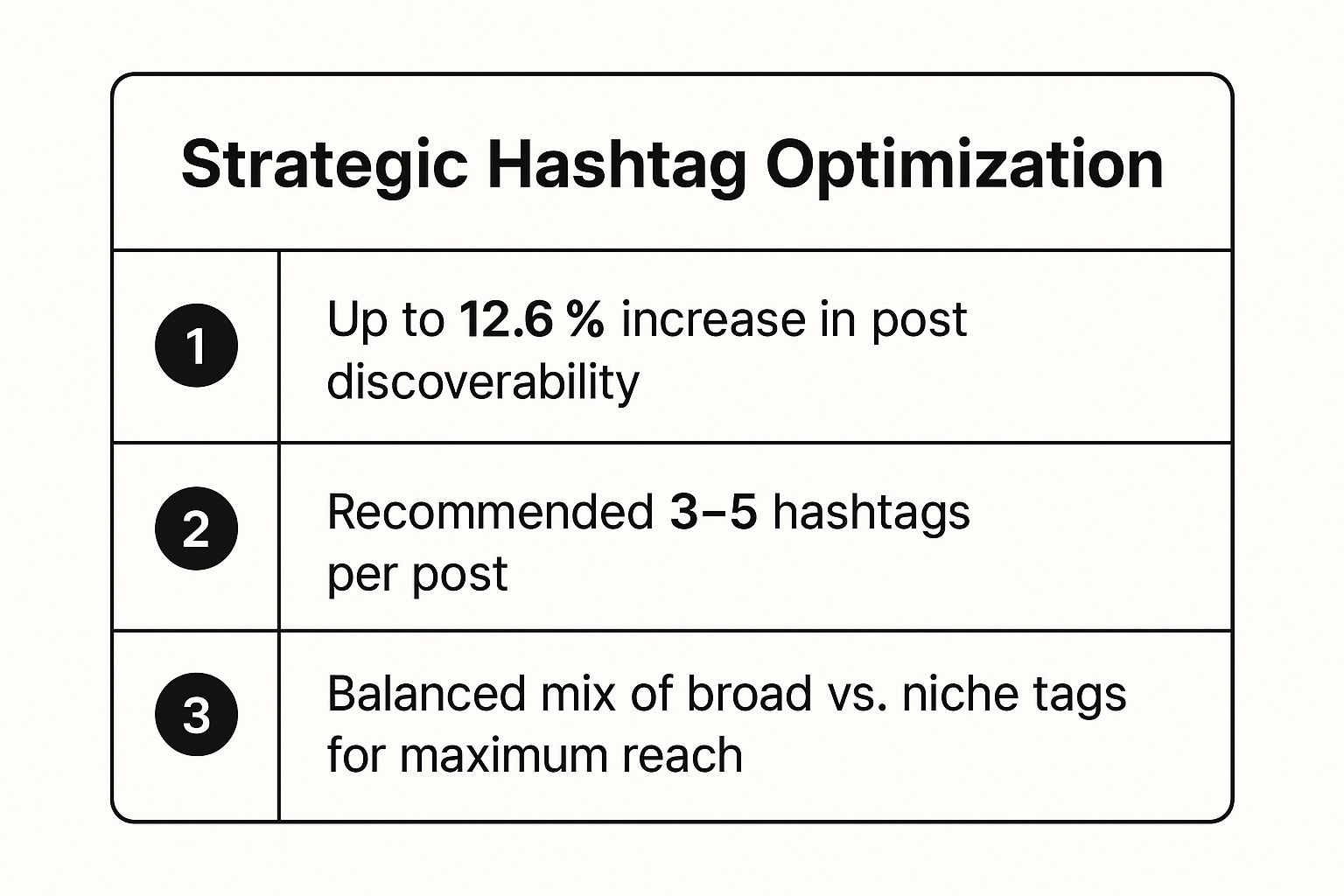
8 LinkedIn Post Best Practices for 2025
Published on 2025-07-01
Welcome to your definitive guide on mastering LinkedIn content creation. In a professional landscape where visibility equals opportunity, crafting posts that not only reach but also resonate with your audience is critical. Generic advice won't cut it anymore. You need a proven strategy, a set of actionable, data-backed linkedin post best practices that can transform your presence from passive to powerful.
This article provides just that. We will move beyond the obvious, offering a deep dive into eight specific, high-impact strategies that top performers use to dominate the platform. From leveraging native video and strategic hashtags to mastering the art of storytelling through personal experience, each point is designed to be immediately implementable. Forget vague theories; this is a roundup of concrete tactics.
By the end of this guide, you will have a clear, actionable plan to elevate your content, drive meaningful engagement, and build a stronger professional brand on LinkedIn. Let's get straight to the methods that deliver real results and unlock your full potential on the world's largest professional network.
1. Master the Native Video Content Strategy
Uploading a video file directly to LinkedIn, known as native video, is one of the most powerful linkedin post best practices for boosting engagement. Instead of sharing a link from YouTube or Vimeo, native videos are hosted on LinkedIn's platform. The platform rewards this by making them autoplay silently in users' feeds, instantly capturing attention and significantly increasing visibility.
LinkedIn's algorithm prioritizes this format because it keeps users on the site longer. This preferential treatment results in substantially higher reach, shares, and comments compared to posts with external video links. It transforms a simple post into a self-contained, engaging experience right within the feed, making it a non-negotiable strategy for anyone serious about growing their presence.

How to Implement a Native Video Strategy
Successfully using native video involves more than just uploading a file. You need a clear plan to create content that resonates with a professional audience.
- Keep it Short and Valuable: Aim for videos under three minutes. Attention spans are short, so deliver your core message quickly. Focus on providing a single, powerful takeaway, whether it's an industry tip, a project update, or a behind-the-scenes look.
- Optimize for Silent Viewing: A majority of users will see your video without sound. Add bold, clear captions or burned-in subtitles to ensure your message is understood. This also makes your content accessible to a wider audience.
- Hook Them Immediately: The first three seconds are critical. Start with a compelling question, a surprising statistic, or a dynamic visual to stop the scroll. Avoid slow introductions or company logos at the very beginning.
- Include a Clear Call-to-Action (CTA): What do you want viewers to do next? End your video by asking a question to spark comments, directing them to a link in the post description, or encouraging them to follow you for more content.
A prime example is HubSpot's educational video series. They create short, animated videos explaining complex marketing concepts, establishing themselves as thought leaders and generating high engagement from their target audience of marketing professionals.
2. Storytelling with Personal Experiences
Sharing personal anecdotes, professional challenges, and authentic experiences is a core component of effective linkedin post best practices. This approach transforms a standard update into a compelling narrative, humanizing your professional brand and forging a genuine emotional connection with your audience. By weaving stories into your content, complex business concepts become more relatable, memorable, and impactful.
This strategy moves beyond simply listing accomplishments; it reveals the person behind the profession. When leaders like Reid Hoffman share stories of entrepreneurial failure or Brené Brown discusses vulnerability, they create a powerful sense of shared experience. This authenticity builds trust and encourages meaningful interaction, making your content stand out in a crowded feed.

How to Implement Storytelling in Your Posts
Crafting a powerful story requires more than just recounting an event. It needs structure and a clear purpose to resonate with a professional network. To find out more about how to do this, you can learn more about how to write engaging LinkedIn posts on autoghostwriter.com.
- Use the 'Challenge-Action-Result' Framework: Structure your narrative clearly. Start by outlining a specific challenge you faced, describe the concrete actions you took to overcome it, and conclude with the tangible result or lesson learned. This simple formula provides a satisfying arc for your reader.
- Include Vivid, Relatable Details: Don't just say you faced a tough project; describe the feeling of staring at a blank whiteboard or the pressure of a looming deadline. Specific details make the story come alive and help your audience place themselves in your shoes.
- Keep It Professionally Relevant: Even personal stories should have a clear professional takeaway. Connect your experience back to a broader lesson about leadership, resilience, teamwork, or industry trends to ensure it provides value to your network.
- End with an Engaging Question: A great story invites participation. Conclude by asking your audience if they've faced similar challenges or what they learned from a comparable experience. This encourages comments and turns your post into a conversation.
3. Strategic Hashtag Optimization
Using a carefully researched mix of hashtags is a core component of modern linkedin post best practices, acting as a powerful tool to boost discoverability. More than just a trend, hashtags categorize your content and make it visible to users who follow specific topics, dramatically expanding your reach beyond your immediate network. They are essential for connecting with a relevant audience actively seeking your expertise.
The LinkedIn algorithm uses hashtags to understand your post's subject matter and serve it to interested members. A strategic approach involves blending broad, niche, and branded tags to maximize visibility across different audience segments. This ensures your content not only reaches a wide audience but also resonates deeply with those most likely to engage, turning passive viewers into active followers.
This infographic highlights the key data points behind an effective hashtag strategy.

As the data shows, a small, well-chosen set of hashtags can significantly increase discoverability without overwhelming your post.
How to Implement Strategic Hashtag Optimization
Effective hashtag use requires a deliberate and researched approach, not just adding popular tags at random. You need a formula that balances reach with relevance.
- Limit to 3-5 Relevant Hashtags: Quality trumps quantity. Overloading your post with hashtags can look spammy and dilute your message. Stick to a focused selection of 3 to 5 tags that are directly related to your content's core topic.
- Balance Broad and Niche Tags: Combine one or two popular, high-traffic hashtags (e.g., #Leadership, #Marketing) with two or three niche-specific ones (e.g., #B2BSaaS, #FintechInnovation). This strategy helps you appear in broad searches while also capturing a highly targeted audience.
- Create and Use a Branded Hashtag: Develop a unique hashtag for your company, campaign, or community, like Adobe's #AdobeLife. Consistently including it in your posts builds a searchable content hub and fosters a sense of community around your brand.
- Research Before You Post: Use LinkedIn's search bar to check the follower count of potential hashtags. This helps you gauge their popularity and relevance, ensuring you select tags that have an active audience but aren't so saturated that your post gets lost.
A great example is Salesforce, which cultivates its ecosystem with the #TrailblazerCommunity hashtag. This tag unites customers, developers, and partners, creating a powerful brand asset and a hub for user-generated content and engagement.
4. Document and Carousel Post Strategy
Harnessing documents and carousels is a cornerstone of modern linkedin post best practices for delivering in-depth information in an engaging, interactive format. Instead of a long text post, you can upload a PDF, PowerPoint, or Word document, which LinkedIn transforms into a swipeable carousel. This format holds user attention longer as they click through each slide, signaling to the algorithm that your content is valuable.
This method allows you to break down complex topics, share detailed infographics, or present case studies in a visually appealing and easy-to-digest manner. Because it encourages active engagement (clicking "next"), LinkedIn's algorithm often rewards these posts with greater organic reach, making them a powerful tool for establishing thought leadership and educating your audience.
How to Implement a Document and Carousel Strategy
Creating an effective carousel goes beyond simply converting a presentation into a PDF. It requires a thoughtful approach to visual storytelling that guides the user from the first slide to the last.
- Start with an Attention-Grabbing Title Slide: Your first slide is your hook. It must be compelling enough to make someone stop scrolling and start swiping. Use a bold headline, a provocative question, or intriguing data to capture immediate interest.
- Maintain Consistent Branding: Use a consistent color palette, font, and logo placement across all slides. Placing your logo on each slide reinforces brand recognition as users swipe through the content, which is especially important if your post goes viral.
- Focus on Readability: Use high-contrast colors and large, clear fonts to ensure your text is easily readable on both desktop and mobile devices. Keep the amount of text on each slide minimal to avoid overwhelming the viewer.
- End with a Clear Call-to-Action (CTA): The final slide is your opportunity to guide your audience. Tell them what to do next: ask a question to encourage comments, prompt them to follow your page, or direct them to a link in the post's description.
A prime example is how consulting firms like McKinsey & Company share comprehensive industry reports as carousels, generating thousands of shares and establishing their authority. For more inspiration, you can find a variety of excellent LinkedIn carousel examples on autoghostwriter.com.
5. Optimal Timing and Frequency Management
Understanding when and how often to post is a cornerstone of effective linkedin post best practices. Publishing content at strategic times, when your target audience is most active, dramatically increases the chances of your post being seen, liked, and shared. It’s not just about creating great content; it’s about delivering it at the moment your network is ready to engage.
The LinkedIn algorithm favors fresh, relevant content, and posting consistently keeps you top-of-mind and visible in your followers' feeds. By analyzing platform analytics and audience behavior, you can pinpoint the optimal windows for engagement. This data-driven approach transforms posting from a shot in the dark into a precise strategy, maximizing your organic reach and ensuring your valuable insights don't get lost in the noise.
How to Implement Optimal Timing and Frequency
A successful timing strategy requires a mix of general best practices and personalized data analysis. You need a consistent schedule that aligns with your specific audience's habits.
- Target Business Hours: A reliable starting point is to post during standard business hours in your primary audience's timezone. Industry research from platforms like Hootsuite and Buffer consistently shows peak engagement on Tuesdays, Wednesdays, and Thursdays, often between 8–10 AM and 12–2 PM.
- Maintain a Consistent Cadence: Aim for a frequency of 3-5 high-quality posts per week. This is the sweet spot for maintaining visibility without overwhelming your network. Consistency is more important than volume; a steady rhythm builds audience expectation and algorithmic favor.
- Leverage LinkedIn Analytics: Use the "Analytics" tab on your profile or company page to find out when your followers are most active. This data is specific to your audience and is far more powerful than general industry benchmarks.
- Schedule in Advance: Use LinkedIn’s native scheduling tool or a third-party app to plan your posts. This ensures you can hit your optimal time slots consistently, even when you're busy. Test different times and days, measure the results, and refine your schedule accordingly.
For a deeper dive into finding the perfect schedule for your content, you can learn more about the best times for LinkedIn posts. By aligning your posting frequency with peak activity hours, you ensure your content gets the immediate traction it needs to perform well.
6. Employee Advocacy and Tag Strategy
Leveraging employee advocacy and a smart tag strategy is one of the most effective linkedin post best practices for exponential reach. This involves encouraging your team to share company content and strategically tagging relevant colleagues or industry leaders in your posts. This approach taps into the power of network effects, turning a single post into a conversation that spans multiple professional circles.
The LinkedIn algorithm rewards posts that generate authentic, early engagement. When a tagged individual or an employee shares your content, their network sees it, signaling to the algorithm that the post is valuable. This validation dramatically expands your visibility beyond your immediate followers, fostering community and building powerful professional relationships that amplify your message.
How to Implement an Employee Advocacy and Tag Strategy
A successful advocacy plan is built on authenticity, not obligation. Your goal is to create a culture where sharing is natural and tagging is a meaningful gesture of inclusion.
- Tag with Relevance and Respect: Only tag people who are genuinely connected to the content, such as a collaborator on a project, a speaker at an event you're discussing, or someone whose work you are referencing. Always prioritize relevance over reach.
- Keep it Focused: Avoid "tag spamming." Limit your tags to a maximum of three to five highly relevant individuals per post. This maintains credibility and prevents your post from looking like a desperate plea for attention.
- Provide Context for the Tag: Don't just tag someone and hope they notice. Weave their name into the post naturally, explaining why you are mentioning them. For example, "Loved the insights on AI ethics from @JaneDoe during her recent keynote."
- Build a Culture of Reciprocity: Encourage a two-way street. Engage with the content of those you tag and support colleagues who share company news. This strengthens relationships and makes future collaboration more likely.
A powerful example is Microsoft, where employees regularly amplify company announcements and initiatives. Their posts often add personal commentary, making the corporate message more relatable and trustworthy, which in turn generates significantly higher engagement than a standard corporate broadcast.
7. Adopt a Question-Based Engagement Strategy
Ending your posts with a thoughtful, open-ended question is a core component of effective linkedin post best practices. This simple technique shifts the dynamic from a one-way broadcast to a two-way conversation, inviting your audience to share their own experiences and insights. It signals that you value their perspective, transforming passive readers into active participants.
The LinkedIn algorithm rewards this engagement heavily. Posts that generate meaningful comment threads are deemed more valuable and are shown to a wider audience. By asking questions, you not only boost your post's visibility but also build a stronger community around your profile, turning your feed into a hub for industry discussion.
How to Implement a Question-Based Strategy
Asking the right kind of question is key to unlocking high-quality engagement. The goal is to spark genuine conversation, not just collect one-word answers.
- Ask Open-Ended Questions: Avoid simple yes/no questions. Instead, ask "how," "why," or "what if" to encourage detailed, thoughtful responses. For example, instead of "Do you like remote work?", ask "What is the single biggest challenge you've faced while leading a remote team?"
- Be Specific and Relevant: Use industry-specific language and context to attract responses from your target audience. A vague question gets vague answers, but a specific one shows you understand your community's unique challenges.
- Engage with Responders: Your work isn't done after posting. Reply to comments promptly to keep the conversation alive. Ask follow-up questions in the replies to dig deeper and show you are actively listening.
- Leverage the Insights: Pay attention to the themes in the responses. You can use this valuable feedback to create a follow-up post summarizing the key insights, which further demonstrates your value to your network.
A great example is how thought leaders like Simon Sinek pose profound leadership questions. His posts often generate thousands of comments, not just because of his following, but because the questions are crafted to make people reflect on their own professional experiences, leading to exceptionally high engagement.
8. Prioritize Professional Value-First Content
Adopting a value-first content strategy is one of the most effective linkedin post best practices for building an authentic, engaged audience. This approach flips the script on traditional marketing by prioritizing educational insights and helpful resources over direct self-promotion. Instead of asking for a sale or a follow, you offer genuine value that solves problems for your professional network.
The core principle is to establish yourself as a credible, trustworthy thought leader. By consistently sharing expertise and useful information without immediate expectation of return, you build a loyal following. This foundation of trust makes your audience far more receptive when you do occasionally share promotional content, as it comes from a source they already respect.
How to Implement a Value-First Content Strategy
Shifting to a value-first mindset requires a strategic approach to content creation and curation. It’s about giving more than you take and focusing on your audience's needs.
- Follow the 80/20 Rule: Dedicate 80% of your posts to providing pure value, such as industry insights, actionable tips, and helpful resources. The remaining 20% can be used for promotional content, like announcing a product launch or sharing a company win.
- Share Actionable Insights, Not Generic Advice: Instead of saying "be productive," share the specific time-management technique you use to save five hours a week. Offer concrete solutions, free templates, or checklists that your audience can immediately apply.
- Focus on Solving Common Problems: Identify the biggest pain points and challenges within your industry. Create content that directly addresses and offers solutions to these problems, positioning you as an indispensable resource.
- Cite Credible Sources and Data: Back up your claims with research and data from reputable sources. This not only enhances your credibility but also enriches the quality of the information you provide, making it more valuable to your network.
A great example is how marketing pioneer Seth Godin shares short, daily insights on his blog, which he cross-posts to LinkedIn. His content consistently provides a fresh perspective on marketing and leadership, building a massive, loyal following that eagerly consumes his books and courses when they are released.
LinkedIn Post Best Practices Comparison
| Strategy | Implementation Complexity 🔄 | Resource Requirements ⚡ | Expected Outcomes 📊 | Ideal Use Cases 💡 | Key Advantages ⭐ |
|---|---|---|---|---|---|
| Native Video Content Strategy | Medium (video creation & upload) | Moderate (video production, editing tools) | High reach & engagement (5x external links) | Brand engagement, product demos, thought leadership videos | Higher visibility, autoplay boost, detailed analytics |
| Storytelling with Personal Experiences | Medium-High (crafting authentic stories) | Low to Moderate (writing and time investment) | Strong emotional engagement, viral potential | Personal branding, thought leadership, relatable messaging | Builds trust, memorable, boosts comments |
| Strategic Hashtag Optimization | Low (research & tagging) | Low (research tools & strategy) | Moderate discoverability increase (~12.6%) | Expanding reach, trend participation, community building | Enhances discoverability, brand hashtag community |
| Document and Carousel Post Strategy | High (design & formatting skills) | Moderate-High (design tools, time-intensive) | Higher engagement (65% over single posts) | Detailed educational content, step-by-step guides | Engages longer, professional appearance, comprehensive |
| Optimal Timing and Frequency Management | Medium (analytics & scheduling) | Low to Moderate (analytics tools, scheduling) | Increased organic reach by 23% | Consistent visibility, audience growth | Maximizes engagement, audience loyalty, efficient posting |
| Employee Advocacy and Tag Strategy | Low-Medium (coordination & tagging) | Low (network utilization & relationship management) | Strong reach amplification (561% network effect) | Amplifying content, networking, relationship building | Expands reach, builds relationships, cross-promotion |
| Question-Based Engagement Strategy | Low-Medium (content crafting & monitoring) | Low (time for managing responses) | Doubles comment rates, stronger discussion | Community building, insight gathering, active engagement | Boosts comments, fosters conversations, gains audience insights |
| Professional Value-First Content | High (research & quality content creation) | High (expertise and time) | 40% higher engagement than promotional posts | Establishing thought leadership, trust building | Builds credibility, attracts quality connections, shares valuable insights |
Putting It All Together: Your Path to LinkedIn Mastery
You’ve just navigated a comprehensive blueprint of advanced LinkedIn post best practices, and now you possess a powerful arsenal of strategies to transform your professional presence. We've journeyed far beyond generic advice, equipping you with a strategic framework that covers the full spectrum of high-impact content creation. From the immersive power of native video and personal storytelling to the structured authority of carousel posts and the analytical precision of hashtag optimization, you have the tools to build a truly magnetic brand.
The core principle tying all these tactics together is a shift in perspective. Instead of asking, "What should I post today?", start asking, "What value can I provide to my audience today?". This value-first mindset is the engine that will drive your success, whether you're sharing an insightful personal experience, posing a thought-provoking question, or packaging your expertise into an easy-to-digest document.
Your Action Plan for LinkedIn Growth
Mastery doesn't happen overnight; it’s built through consistent, intentional action. The key is to avoid feeling overwhelmed and instead focus on incremental progress. Here’s how you can start implementing these best practices immediately:
- Select Your Starting Point: Don't try to implement all eight strategies at once. Choose one or two that feel most aligned with your current style or goals. If you're a strong writer, begin with storytelling. If you have great visual assets, focus on a carousel post.
- Commit to Consistency: The true power of these strategies is unlocked through repetition. Whether you decide to post twice a week or five times, stick to your schedule. Consistent application of these LinkedIn post best practices trains the algorithm to favor your content and teaches your audience when to expect value from you.
- Analyze and Adapt: Your LinkedIn Analytics page is your feedback loop. Pay close attention to what resonates. Which formats get the most engagement? What topics spark the most conversation? Use this data to refine your approach, doubling down on what works and experimenting with new ideas.
Remember, the goal isn't just to get more likes; it's to build a meaningful professional network, establish yourself as a thought leader, and create tangible opportunities. Each post is a building block in your professional legacy. By applying these strategies, you’re not just chasing vanity metrics. You are actively investing in your personal brand, fostering a community of engaged peers, and positioning yourself as an indispensable voice in your industry. This is how you turn your LinkedIn profile from a static resume into a dynamic platform for growth and influence.
Ready to implement these best practices without the heavy lifting? autoghostwriter uses advanced AI to help professionals and teams create authentic, high-quality LinkedIn content based on proven strategies. Stop staring at a blank screen and start building your brand by visiting autoghostwriter to see how it can streamline your content creation today.